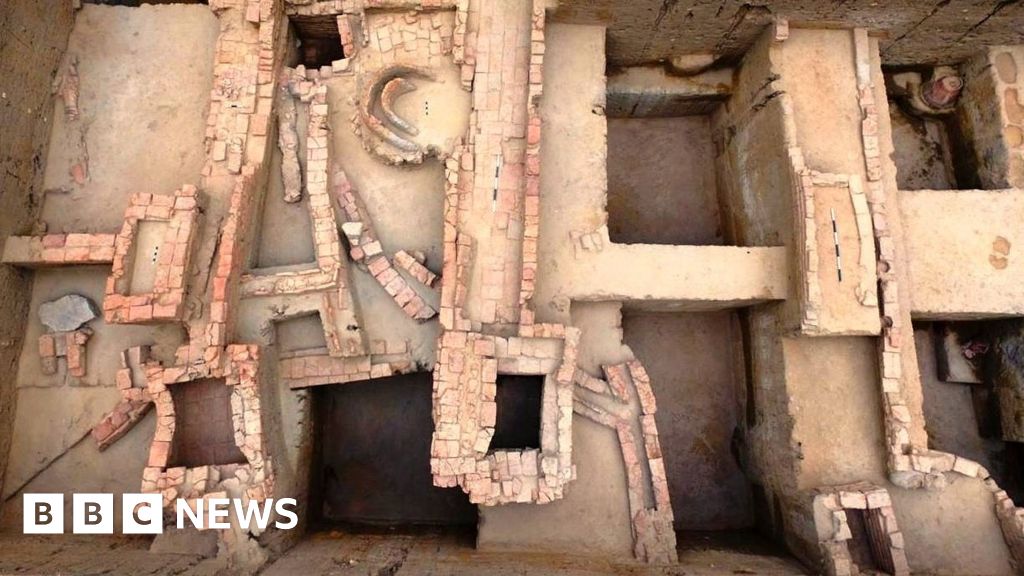生成中...【新闻摘要】
印度南部泰米尔纳德邦的基拉迪村考古发现引发了一场"南北文明大战"!这里的考古学家挖出了2500年前的砖结构和水系统,直接挑战了"印度文明起源于北方"的传统认知。北方学者坚持认为南方的泰米尔文字是从北方阿育王文字演变而来,但南方考古学家现在宣称发现了更古老的文字——这简直就像在说"我们南方人早就开化了,不用你们北方人来教"。更精彩的是,这场学术争论已经演变成政治角力,泰米尔政客指责中央政府"打压南方文化自豪感"。看来在印度,考古不仅是挖土,更是在挖某些人的"历史优越感"啊!
The ancient site that has become a political flashpoint in India
印度古遗址引发的政治与文化之争
ASI A view of an excavated site in Keeladi where archaeologists have found evidence of industrial activity
印度考古调查局:基拉迪遗址发掘现场发现古代工业活动证据
The Keeladi village in India's southern Tamil Nadu state has unearthed archeological finds that have sparked a political and historical battle.
印度泰米尔纳德邦基拉迪村的考古发现引发了一场政治与历史之争
Amid coconut groves, a series of 15ft (4.5m) deep trenches reveal ancient artefacts buried in layers of soil - fragments of terracotta pots, and traces of long-lost brick structures.
在椰树林中,4.5米深的探沟揭露了层层土壤下的古代遗存——赤陶罐碎片和消失已久的砖结构痕迹
Experts from the Tamil Nadu State Department of Archaeology estimate the artefacts to be 2,000 to 2,500 years old, with the oldest dating back to around 580 BCE.
泰米尔纳德邦考古局专家估计这些文物有2000-2500年历史,最早可追溯至公元前580年
They say these findings challenge and reshape existing narratives about early civilisation in the Indian subcontinent.
这些发现挑战并重塑了关于印度次大陆早期文明的现有叙事
With politicians, historians, and epigraphists weighing in, Keeladi has moved beyond archaeology, becoming a symbol of state pride and identity amid competing historical narratives.
随着政客、历史学家和碑铭学家的介入,基拉迪已超越考古范畴,成为不同历史叙事下的邦族自豪象征
Yet history enthusiasts say it remains one of modern India's most compelling and accessible discoveries - offering a rare opportunity to deepen our understanding of a shared past.
历史爱好者称这仍是现代印度最引人入胜的考古发现之一,为理解共同过去提供了难得机会
Keeladi, a village 12km (7 miles) from Madurai on the banks of the Vaigai river, was one of 100 sites shortlisted for excavation by Archaeological Survey of India (ASI) archaeologist Amarnath Ramakrishnan in 2013.
2013年印度考古调查局专家将瓦盖河畔的马杜赖附近村庄基拉迪列入百处候选发掘地点
He selected a 100-acre site there because of its proximity to ancient Madurai and the earlier discovery of red-and-black pottery ware by a schoolteacher in 1975.
选择该地因靠近古马杜赖城,且1975年有教师在此发现红黑陶器
Tamil Nadu State Department of Archaeology Burial urns near Keeladi, containing human skeletons and goods such as food and pots
泰米尔纳德邦考古局:基拉迪附近出土的葬瓮,内有人骨及食物器皿等随葬品
Since 2014, 10 excavation rounds at Keeladi have uncovered over 15,000 artefacts - burial urns, coins, beads, terracotta pipes and more - from just four of the 100 marked acres.
2014年以来十轮发掘在百亩规划区中的四亩地就出土1.5万件文物(包括葬瓮、钱币、珠饰、陶管等)
Many are now displayed in a nearby museum.
多数文物现陈列于附近博物馆
Ajay Kumar, leading the state archaeology team at Keeladi, says the key finds are elaborate brick structures and water systems - evidence of a 2,500-year-old urban settlement.
考古队长指出精美砖构与水利系统是证明2500年前城市聚落的关键证据
"This was a literate, urban society where people had separate spaces for habitation, burial practices and industrial work," Mr Kumar says, noting it's the first large, well-defined ancient urban settlement found in southern India.
"这是有文字的城市文明,居民区分生活、丧葬和工业区域",这是南印度首次发现明确的大型古代城市遗址
Since the Indus Valley Civilisation's discovery in the early 1900s, most efforts to trace civilisation's origins in the subcontinent have focused on northern and central India.
自20世纪初发现印度河流域文明以来,学界多聚焦于北印度和中印度的文明溯源
So, the Keeladi finds have sparked excitement across Tamil Nadu and beyond.
因此基拉迪发现令泰米尔纳德邦内外振奋
William Daniel, a teacher from neighbouring Kerala, said the discoveries made him feel proud about his heritage.
来自邻邦喀拉拉邦的教师表示这些发现令他为自身文化传承感到骄傲
"It gives people from the south [of India] something to feel proud about, that our civilisation is just as ancient and important as the one in the north [of India]," he says.
"这让我们南方人得以自豪——我们的文明与北方同样古老重要"
Red and black pottery excavated from the site, displayed at the Keeladi Museum
基拉迪博物馆展出的遗址出土红黑陶器
The politics surrounding Keeladi reflects a deep-rooted north-south divide - underscoring how understanding the present requires grappling with the past.
基拉迪引发的政治争议反映了根深蒂固的南北分歧,凸显理解当下必须直面历史
India's first major civilisation - the Indus Valley - emerged in the north and central regions between 3300 and 1300 BCE.
印度首个主要文明印度河流域文明(公元前3300-1300年)兴起于北印度和中印度
After its decline, a second urban phase, the Vedic period, rose in the Gangetic plains, lasting until the 6th Century BCE.
衰落后,第二波城市化浪潮吠陀文明在恒河平原兴起(持续至公元前6世纪)
This phase saw major cities, powerful kingdoms and the rise of Vedic culture - a foundation for Hinduism.
此时期出现大城市、强盛王国和作为印度教基石的吠陀文化
As a result, urbanisation in ancient India is often viewed as a northern phenomenon, with a dominant narrative that the northern Aryans"civilised" the Dravidian south.
因此古印度城市化常被视为北方现象,主流叙事称北方雅利安人"开化"了南方达罗毗荼人
This is especially evident in the mainstream understanding of the spread of literacy.
文字传播的主流认知尤其体现这点
It is believed that the Ashokan Brahmi script - found on Mauryan king Ashoka's rock edicts in northern and central India, dating back to the 3rd Century BCE - is the predecessor of most scripts in South and Southeast Asia.
学界认为公元前3世纪阿育王石刻上的婆罗米文是南亚东南亚多数文字的始祖
Epigraphists like Iravatham Mahadevan and Y Subbarayalu have long held the view that the Tamil Brahmi script - the Tamil language spoken in Tamil Nadu and written in the Brahmi script - was an offshoot of the Ashokan Brahmi script.
碑铭学家长期认为泰米尔婆罗米文(泰米尔语的婆罗米文字体)衍生自阿育王婆罗米文
But now, archaeologists from the Tamil Nadu state department say that the excavations at Keeladi are challenging this narrative.
但泰米尔纳德邦考古局称基拉迪发掘正在挑战这一观点
"We have found graffiti in the Tamil Brahmi script dating back to the 6th Century BCE, which shows that it is older than the Ashokan Brahmi script. We believe that both scripts developed independently and, perhaps, emerged from the Indus Valley script," Mr Kumar says.
"我们发现公元前6世纪的泰米尔婆罗米文涂鸦,比阿育王文字更古老,两种文字可能独立发展并共同源自印度河文字"
Keeladi Museum Archaeologists say some graffiti found in Keeladi resembles that of the Indus Valley
基拉迪博物馆:考古学家称部分涂鸦与印度河流域文字相似
Epigraphist S Rajavelu, former professor of marine archaeology at the Tamil University, agrees with Mr Kumar and says other excavation sites in the state too have unearthed graffiti in the Tamil Brahmi script dating back to the 5th and 4th Century BCE.
碑铭学家证实该邦其他遗址也出土公元前5-4世纪的泰米尔婆罗米文涂鸦
But some experts say that more research and evidence are needed to conclusively prove the antiquity of the Tamil Brahmi script.
但部分专家认为需要更多研究证据来确证泰米尔婆罗米文的古老性
Another claim by the state department of archaeology that has ruffled feathers is that the graffiti found on artefacts in Keeladi is similar to that found in the Indus Valley sites.
另一引发争议的说法是基拉迪器物上的涂鸦与印度河流域文字相似
"People from the Indus Valley may have migrated to the south, leading to a period of urbanisation taking place in Keeladi at the same time it was taking place in the Gangetic plains," Mr Kumar says, adding that further excavations are needed to fully grasp the settlement's scale.
"印度河流域居民可能南迁,使基拉迪与恒河平原同期出现城市化",但需更多发掘来确认聚落规模
But Ajit Kumar, a professor of archaeology at Nalanda University in Bihar, says that this wouldn't have been possible.
那烂陀大学考古学教授认为当时的技术条件不可能实现大规模南迁
"Considering the rudimentary state of travel back then, people from the Indus Valley would not have been able to migrate to the south in such large numbers to set up civilisation," he says.
"考虑到原始交通条件,印度河流域居民不可能大规模南迁建立文明"
He believes the finds in Keeladi can be likened to a small"settlement".
他认为基拉迪遗址更可能是小型"聚落"
Keeladi Museum Pipes made of terracota were used to transport water
基拉迪博物馆:用于输水的赤陶管道
While archaeologists debate the findings, politicians are already drawing links between Keeladi and the Indus Valley - some even claim the two existed at the same time or that the Indus Valley was part of an early southern Indian, or Dravidian, civilisation.
当考古学家争论时,政客已将基拉迪与印度河文明关联,甚至声称二者同期存在或印度河文明属早期南印度/达罗毗荼文明
The controversy over ASI archaeologist Mr Ramakrishnan's transfer - who led the Keeladi excavations - has intensified the site's political tensions.
基拉迪发掘负责人被调职的争议加剧了政治紧张
In 2017, after two excavation rounds, the ASI transferred Mr Ramakrishnan, citing protocol.
2017年两轮发掘后,印度考古调查局以程序为由将其调离
The Tamil Nadu government accused the federal agency of deliberately hindering the digs to undermine Tamil pride.
泰米尔纳德邦政府指控中央机构故意阻碍发掘以打压泰米尔自豪感
The ASI's request in 2023 for Mr Ramakrishnan to revise his Keeladi report - citing a lack of scientific rigour - has intensified the controversy.
2023年要求其修改报告(称缺乏科学严谨性)进一步激化矛盾
He refused, insisting his findings followed standard archaeological methods.
他拒绝修改,坚称研究遵循标准考古方法
In June, Tamil Nadu Chief Minister MK Stalin called the federal government's refusal to publish Mr Ramakrishnan's report an"onslaught on Tamil culture and pride".
6月泰米尔纳德邦首席部长指责中央拒发报告是"对泰米尔文化与自豪感的打击"
State minister Thangam Thennarasu accused the Bharatiya Janata Party (BJP)-led federal government of deliberately suppressing information to erase Tamilian history.
邦部长指控印人党领导的中央政府蓄意压制信息以抹杀泰米尔历史
India's Culture Minister Gajendra Singh Shekhawat has now clarified that Mr Ramakrishnan's report has not been rejected by the ASI but is"under review," with expert feedback yet to be finalised.
文化部长澄清报告未被否决而是"正在审核",专家意见尚未最终确定
Tamil Nadu State Department of Archaeology A terracota ring well buried inside the ground
泰米尔纳德邦考古局:埋藏地下的赤陶圈井

